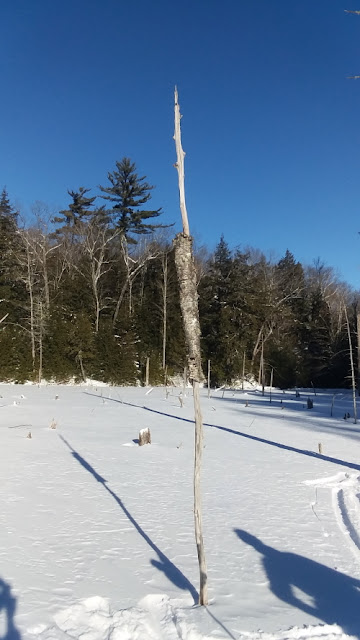One of my favorite aspects of winter is being able to access some really neat places that one just can't get to when the world isn't frozen into a solid block of ice. Last week a backcountry ski excursion with a couple of skiing companions (thanks T&L H!) in the Hamlin conservation area brought us to this bizarre sight in the middle of Double-dammed Beaver Pond:
 |
| A lone spire stands in Double-dammed Pond. |
We just stared at it for while trying to understand what it was all about.
Our conclusion is that the tree died as the beavers dammed the pond high enough to drown its roots, and over time the cambium and the sapwood in the tree trunk rotted away. Yet the sturdy, dry, dead heartwood, strengthened with lignin, survived the years and kept the tree standing. Also surviving while the layers between the bark and heartwood decomposed, was a section of outer bark.
The outer bark's purpose in life is to protect a tree from weather and insects, and this demonstrates its tenacity in fulfilling its mission even long after the tree is past the point of no return. This ring of bark is apparently suspended by a spur on the trunk, with the holes in the porous bark letting the wind whip through it over the years as it hung on trying to do its part in the life of the tree.
The US Forest Service has this image and associated description of the anatomy of a tree on its website.
I'd say this is a yellow birch based on the appearance of the bark and the fact that swamps are listed as habitat for yellow birch. It's yet another first for me in a never ending path of discovery as I wander through the wonders of nature.
Here's another object that I learn more about in winter than in summer.
 |
| Beaver lodges, though covered with snow, can be observed up close in winter. |
In winter one can tell if a beaver lodge is occupied or not by the vent holes - if occupied there will be ice crystals on a frigid day as the humid breath of the inhabitants freezes as it exits the warmth of the lodge. Then there are the tracks in the snow which reveal what animals visit the lodge. I often see mouse and fox tracks running to and over a beaver lodge in winter, the mouse looking for a warm and safe place to live, the fox most certainly following their odors in search of a meal. This week I saw something I haven't before: weasel tracks leading right into this beaver lodge through a tiny hole.
 |
| In we go. |
Seeing only a single set of tracks I thought, could a weasel be living in there? I know beavers allow other animals such as mice and muskrats to share their lodge, but a weasel? Well, there on the other side of the lodge was the exit track. The weasel evidently went in one side and out the other.
 |
| And out we come. |
I'll never know if it caught a mouse as it passed through.
The tracks leading away from the lodge say "weasel" - a narrow pair of prints side-by-side in a straight line as the weasel bounds along.
 |
| A trademark weasel print. |
There are several members of the weasel family in New Hampshire but these are probably from a mink or maybe an ermine. Being near water, I'll guess mink.
Going a few days without snow lends some new information about wildlife activity around the lakes. While fresh snow every few days covers up prior tracks, a few clear days provides data on the most popular wildlife trails. This route is clearly an animal superhighway.
 |
| Interchange 7 on the Wicwas Turnpike |
Along this route I saw the tracks of fox, coyote, and river otter as well as lots of mice leading on and off the ice.
This week one of our fellow bird watchers noted how many birds were at their feeders on these cold mornings (thank you RP!). A cold snap like this means those birds have to replenish all the extra calories they burn every night just to keep warm. And they seem to be bolder in getting that needed sustenance - I was standing just two feet away from a feeder and that didn't slow them down one bit.
 |
| Incoming! |
On the subject of birds, did you hear about the rare Stellers Sea-Eagle that's travelled from Alaska to New England? (Thanks NM for sharing this story!) It's the largest raptor in the world, and it's first time one has ever been observed here. It's a rare bird with only 4000 on the planet and it's causing quite a stir in the birding community. The Steller Sea-Eagle has a life span of 30 years, so if it decides it likes New England, it's conceivable another bird could come along, they could mate, and they could establish a community here. It's even possible it could mate with a resident bald eagle. But it's more likely it will move on, living a life as a lonely vagrant travelling around the continent. It was seen most recently two days ago in Boothbay Maine. I should take a trip up to Maine to look for it!
I'll close with one more neat perspective of the world as seen from the surface of a frozen-solid Lake Wicwas.
 |
| Hemlock cones hang over Lake Wicwas. |
Nature's beauty is everywhere.



Love those tiny hemlock cones. Over the years we have collected a few glass jars full of them. We put those jars out every year to decorate the house for winter.
ReplyDelete